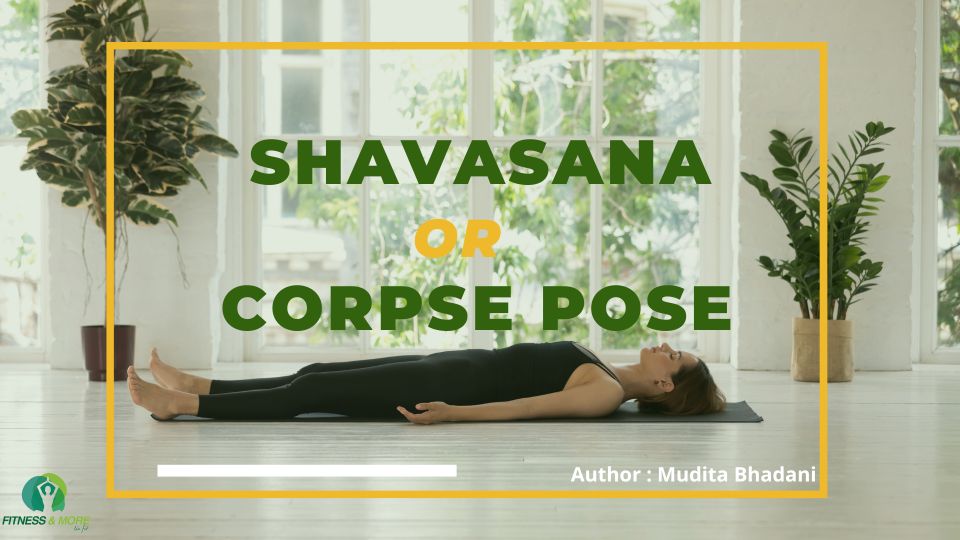Shavasana is a restorative posture in Yoga and is one of the easiest postures to perform but at the same time is one of the most difficult postures to master. Various Yoga practitioners who can perform very difficult postures with ease find it difficult to lie in this posture for some time. The posture requires a conscious effort to completely relax the body with the mind in an attentive state.
It is a preparatory posture for deep meditation practices.
The posture helps to relieve the tension in the entire body and relaxes the mind. It is usually performed for 15-20 minutes at the end of Yoga practice or during the practice when the body is tired.
Mythology and Origins
The word Shavasana consists of two Sanskrit words, Shava and Asana. Shava means “corpse” and Asana means “posture”. In this posture, the body lies down on the floor with no movement and therefore looks like a dead body and corpse. Therefore, it is called Shavasana.
The posture is also called Mrtyasana, Corpse pose, Dead body pose, or Deep relaxing pose The ultimate goal of Yoga can be reached only with the cessation of all activity i.e. physical and mental, and this cessation is allowed during Shavasana. If we think deeply, it would be apt to say that this asana teaches us to surrender completely, abandon all activities, let go of all desires of the body and prepare for the inevitable.
Yoga Scripture
As per 17th century Gheranda Samhita, Shavasana is one of the important 32 postures out of eighty-four lakh postures taught by Siva. As per verse 19 of Chapter 2, “Lying flat on the ground like a corpse is called Mritasana. It destroys fatigue and quiets the agitation of mind.”
As per Hathayoga Pradipika – Chapter 1, Verse 32, “Lying flat on the ground with the face upwards, in the manner of a dead body, is Shavasana. It removes tiredness and enables the mind (and whole body) to relax”.
Benefits of Shavasana
Shavasana is known as the pose of relaxation and it is essential to practice in between other asanas or after a hectic day. The benefit of Shavasana is as follows:
- Deep breathing without any movements in the body soothes the nerves, calms the mind, and helps to fight anxiety, depression, and insomnia.
- It heals the body and removes fatigues and tension from all the muscles of the body
- It helps to maintain equilibrium in the body
- It helps in the improvement of focus, concentration, and memory
- It helps to increase the awareness of the body
- It connects the mind, body, and soul.
- It helps to fight high blood pressure and heart diseases.
- It helps to release your emotions, impressions which are there in your body for a long time
- It improves the blood circulation and immunity of the body
- It is the best cooling down exercise or posture after a vigorous workout session
- It rejuvenates the entire body and helps to end the Yogic practice on a positive note.
- Regular practice of Shavasana just before going to sleep induces calm and restful sleep.
In short, regular practice of the pose has a lot of benefits and it impacts the entire body in a positive manner.
Preparatory Poses
The asana should be performed after you have done all the active or strenuous asanas and pranayama.
Who Should Not Do Shavasana?
Everyone can do Shavasana.
Duration For Shavasana
You can start with 10-15 minutes and can perform for as much time as you want. There are no negative effects to it. Practice will also depend upon how much active exercise you have done and how much your body is tired. Generally, a practice of 15 minutes is sufficient.
Steps To Perform Shavasana
The steps to perform Shavasana are as follows:
- Lie down straight on the floor on your back with hands on the floor and palms facing up, near the thighs. The fingers should be slightly curled upwards.
- Maintain hip-width distance between feet. The entire body should be in a comfortable position.
- Keep your head, back, and legs in alignment. Your head should not role on the sides
- Close your eyes and breathe deeply through your nostrils. Keep your mouth closed
- Keep your mind aware and do not sleep in Shavasana. You should be aware to feel every movement of your body.
- Adjust yourself and then do not move any part of your body. Try to sink to the floor and feel that your body is getting heavy.
- Relax your mind and body and concentrate on your breathing.
- Feel that with each inhalation positive vibes are coming in and with each exhalation, the body is getting free of all the stress and negative vibes
- Set an intention for the practice, as in when you complete Shavasana what do you expect from the body?
Once the body is in the Shavasana position, the practice of following, or a mix of the following can be done.
Alternative 1
- Concentrate on your breathing and start counting your breath. Start from counting no. 27 to zero
- Count 27 and then deep inhale through your nostrils and then exhale completely. Then count 26 and follow the same process.
- If you fall asleep or forget your counting then start again from 27 and follow the same process
- Your mind will wander and will have so many thoughts of the daily day-to-day activities, things which you will never think of in normal hours, then let it wander, don’t suppress it. Also, don’t think about that thought. Just let it be and concentrate on your counts.
- After some time of practice, the thoughts will get reduced and you will be able to concentrate.
- The counting will help your mind to be in an awareness state while your body will relax while concentrating on breathing.
Alternative II
- Another alternative is to try focusing on your body parts with inhalation and exhalation. You can start from the head or from your toe.
- Start from the big toe of the right leg and try to look at it with closed eyes and then move forward to the other toes. Feel that your toe is light and free from any tension and stress. If any stress is there, it’s moving out of the body in every exhalation. Concentrate on the body part for a few seconds and then move to the next part.
- You can move forward to ankles, calf muscles, knee, then thighs, hamstrings, then your entire right leg. Then shift your attention to another leg. Visualize that each and every part is healthy and relaxed.
- After that shift your attention to the lower back, stomach, upper back, wrist, fingers, and hands and follow the same process mentioned above. You can focus on the heart, lungs, neck, head, and then the entire body.
- Concentrating on the entire body will make you feel light and relaxed.
Common
- After focusing on the body or completing counting, take deep 5-6 breaths. Then slowly move your legs, and hands and try to feel the mat on which you are lying.
- Then turn to your right side and sit in the Sukhasana position. Do not open your eyes during practice
- Chant the Om mantra 3 times and then rub your palms and put it on your eyes.
- After the entire practice, you will feel relaxed and calm.
Counter pose
There are no counter poses. It is a relaxing pose
Guided Meditation
Various Guided meditations are available on youtube, which can be used by beginners for practice. One of the guided meditations, that I used is as follows:
Further, various apps such as “think right me” are available which can also be used.
Tips/ Precautions for Beginners
- As a beginner, start by concentrating on your breathing for 5-10 minutes. Once you are able to concentrate on your breathing for 10 minutes with ease, try going further.
- Try to do it in a quiet place with less light. It will help to concentrate better
- In the starting, you will fall asleep without knowing, therefore, try to set an intention that “I will not sleep and try to say it to yourself a couple of times before starting Shavasana.
- People also face a situation wherein a lot of thoughts wander in the mind, resulting in difficulty concentrating. Try to focus on your breathing and do not avoid the thoughts or forcefully try to stop them. The best way is to acknowledge them but not think about them i.e. let them go and continue to focus on breathing.
- For some people, it is very uneasy to say in the same position for some time without moving the body. In this situation, try from 5 minutes to stay in the same position and gradually increase the time.
- Sometimes, you will also feel that time is not passing and a feeling of the void as you are not doing anything and your body is not used to it. Then, try concentrating on body parts. With time and practice, all the above problems will get resolved.
- Try to surrender your body and stop fighting.
You can also keep a towel below the knee or some bolsters below the back or some support below the neck if required as per your ease.
My Experience with Shavasana
My memory of this particular posture is since childhood, wherein I have seen my father doing it and as a child, I used to the thought, whenever he wants to sleep, he tells us that he is doing Shavasana… hehe
There are various memes that say that the only posture one wants to do is Shavasana. To be honest, I found this as one of the most difficult postures.
When I initially started doing it, most of the time, I used to sleep. For five minutes I was listening to the instructions, and after that, I didn’t know what was being said as I slept. A couple of times used to get so many thoughts that were difficult to handle or sometimes, felt a void, resulting in anxiety and not being able to concentrate. The only solution that I was able to find is to concentrate on breathing or to count and let thoughts come and go. You simply say Let it be.
To date, I say to myself “Sona nai h jagruk rehna hai” before practice and try to focus on breathing. I would say that with practice, the time I can stay in Shavasana has increased, and completing the practice with Shavasana helps me to start my day in a much more efficient manner and with a sense of completeness and satisfaction.
On this Teacher’s day, Gratitude to my trainer “Rohit Joshi” who has helped me in my Yoga Practice including Shavasana.
I will end this article with the words that he always says and his key mantra “Practice and Patience” HAPPY DOING YOGA!!


I used to think that shavasana is the most easy yoga pose….you just have to lie down and do noting…but mudita u changed my mind…after reading your article I realised that it is more than just lying down….happy doing yoga